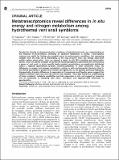| dc.contributor.author | Sanders, J. G. | |
| dc.contributor.author | Beinart, R. A. | |
| dc.contributor.author | Stewart, F. J. | |
| dc.contributor.author | Delong, Edward | |
| dc.contributor.author | Girguis, P. R. | |
| dc.contributor.author | DeLong, Edward Francis | |
| dc.date.accessioned | 2014-09-09T20:45:55Z | |
| dc.date.available | 2014-09-09T20:45:55Z | |
| dc.date.issued | 2013-04 | |
| dc.date.submitted | 2013-01 | |
| dc.identifier.issn | 1751-7362 | |
| dc.identifier.issn | 1751-7370 | |
| dc.identifier.uri | http://hdl.handle.net/1721.1/89405 | |
| dc.description.abstract | Despite the ubiquity of chemoautotrophic symbioses at hydrothermal vents, our understanding of the influence of environmental chemistry on symbiont metabolism is limited. Transcriptomic analyses are useful for linking physiological poise to environmental conditions, but recovering samples from the deep sea is challenging, as the long recovery times can change expression profiles before preservation. Here, we present a novel, in situ RNA sampling and preservation device, which we used to compare the symbiont metatranscriptomes associated with Alviniconcha, a genus of vent snail, in which specific host–symbiont combinations are predictably distributed across a regional geochemical gradient. Metatranscriptomes of these symbionts reveal key differences in energy and nitrogen metabolism relating to both environmental chemistry (that is, the relative expression of genes) and symbiont phylogeny (that is, the specific pathways employed). Unexpectedly, dramatic differences in expression of transposases and flagellar genes suggest that different symbiont types may also have distinct life histories. These data further our understanding of these symbionts’ metabolic capabilities and their expression in situ, and suggest an important role for symbionts in mediating their hosts’ interaction with regional-scale differences in geochemistry. | en_US |
| dc.description.sponsorship | National Science Foundation (U.S.) (OCE-0732369) | en_US |
| dc.description.sponsorship | National Science Foundation (U.S.) (GRF grant no. DGE-1144152) | en_US |
| dc.description.sponsorship | Gordon and Betty Moore Foundation (Investigator) | en_US |
| dc.description.sponsorship | Agouron Institute | en_US |
| dc.language.iso | en_US | |
| dc.publisher | Nature Publishing Group | en_US |
| dc.relation.isversionof | http://dx.doi.org/10.1038/ismej.2013.45 | en_US |
| dc.rights | Creative Commons Attribution-NonCommercial-NoDerivs 3.0 Unported License | en_US |
| dc.rights.uri | http://creativecommons.org/licenses/by-nc-nd/3.0/ | en_US |
| dc.source | ISME Journal | en_US |
| dc.title | Metatranscriptomics reveal differences in in situ energy and nitrogen metabolism among hydrothermal vent snail symbionts | en_US |
| dc.type | Article | en_US |
| dc.identifier.citation | Sanders, J G, R A Beinart, F J Stewart, E F Delong, and P R Girguis. “Metatranscriptomics Reveal Differences in in Situ Energy and Nitrogen Metabolism Among Hydrothermal Vent Snail Symbionts.” ISME J 7, no. 8 (April 25, 2013): 1556–1567. | en_US |
| dc.contributor.department | Massachusetts Institute of Technology. Department of Civil and Environmental Engineering | en_US |
| dc.contributor.department | Parsons Laboratory for Environmental Science and Engineering (Massachusetts Institute of Technology) | en_US |
| dc.contributor.mitauthor | DeLong, Edward | en_US |
| dc.relation.journal | ISME Journal | en_US |
| dc.eprint.version | Final published version | en_US |
| dc.type.uri | http://purl.org/eprint/type/JournalArticle | en_US |
| eprint.status | http://purl.org/eprint/status/PeerReviewed | en_US |
| dspace.orderedauthors | Sanders, J G; Beinart, R A; Stewart, F J; Delong, E F; Girguis, P R | en_US |
| mit.license | PUBLISHER_CC | en_US |
| mit.metadata.status | Complete | |
